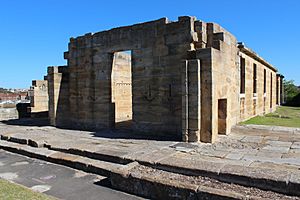Cockatoo Island Convict Barracks Block facts for kids
Quick facts for kids Convict Barracks Block |
|
|---|---|

Cockatoo Island barracks
|
|
| Location | Cockatoo Island, Sydney Harbour, New South Wales, Australia |
| Official name: Barracks Block | |
| Type | Listed place (Historic) |
| Designated | 22 June 2004 |
| Reference no. | 105257 |
| Lua error in Module:Location_map at line 420: attempt to index field 'wikibase' (a nil value). | |
The Convict Barracks Block is an old building on Cockatoo Island in Sydney Harbour, Australia. It was once a place where convicts lived. Today, it's a special heritage site, added to the Australian Commonwealth Heritage List in 2004.
Contents
What is the Convict Barracks Block?
The Convict Barracks Block is a historic building on Cockatoo Island. It was built for convicts and is part of the larger Prison Barracks Precinct. This building is made of sandstone and has a unique U-shape. It used to have hospital rooms, a kitchen, and a dining area. Over time, it was changed for different uses.
A Look Back: History of Cockatoo Island
How Cockatoo Island Became a Prison
Cockatoo Island became a prison in 1839. This happened after the Governor of New South Wales, George Gipps, suggested it. He wanted to send convicts there after another prison on Norfolk Island closed. The prison buildings, including the Barracks Block, were ready by October 1841. One of the first jobs for the convicts was to dig large grain storage areas.
From Prison to Dockyard and School
In 1857, the Fitzroy Dock was built on the island. This made Cockatoo Island a major place for repairing ships. In 1869, the prisoners were moved away. The prison buildings then became a school for girls and a reformatory in 1871. The dockyard area was separated from the school by a fence.
After the girls left in 1888, prisoners returned to the island. It continued as a prison until about 1909. Meanwhile, the dockyard grew even bigger. The Sutherland Dock was built in 1890. Cockatoo Island became the main state dockyard for New South Wales.
Cockatoo Island in the World Wars
In 1913, after Australia became a federation, Cockatoo Island became a Commonwealth Dockyard. It played a very important role in building ships for the Royal Australian Navy. It also helped during the First World War. The old prison buildings were used as offices then.
From 1933, a company leased the dockyard. The island was very important during the Second World War. After the war, the dockyard continued to operate. It even added facilities for submarines. The dockyard finally closed in 1992. Today, the island is managed by the Sydney Harbour Federation Trust.
Building the Barracks Block
The Convict Barracks Block was built between 1839 and 1842. It was designed by Colonel George Barney, a very important engineer in the colony. The building originally had hospital wards, a cookhouse, and a mess shed. There were plans to add a second floor in 1849, but this never happened. Later, other parts like a toilet block were added.
The barracks were used by the Industrial School and then by prisoners again in 1888. When the Commonwealth took over, the building became offices.
Why is the Barracks Block Important?
The Convict Barracks Block and other buildings from that time are very special. They are the only remaining convict public works complex in New South Wales. This means they were paid for by the British government, not the local colony. They are also one of the most complete groups of convict buildings in Australia.
What Does the Barracks Block Look Like Now?
The barracks is a single-storey building made of sandstone. It has a unique U-shape with an enclosed courtyard. The roof is pitched and made of different materials like corrugated iron. There is also a verandah. During the Second World War, two rooms were turned into air raid shelters. The building has been changed many times over the years. Its style is known as Old Colonial Georgian.
Condition of the Barracks
The barracks has been changed a lot for different uses. Some changes made during the Second World War were quite damaging. Some materials used are not ideal. However, in the 1990s, a new roof was put on, and other repairs were done. Some of the stonework showed signs of decay in 1997.
Why is it a Heritage Site?
The Convict Barracks Block was added to the Australian Commonwealth Heritage List in 2004. This means it is very important for several reasons:
- History: It shows how convicts were managed in early Australia. It also tells the story of Cockatoo Island as a school and a major shipyard.
- Rarity: It's part of a rare group of convict buildings. It's one of the few examples of a convict barracks from that time.
- Special Features: It's part of one of the most complete collections of convict buildings in Australia.
- Important People: It was designed by Colonel George Barney, a very important person in the colony's history.

